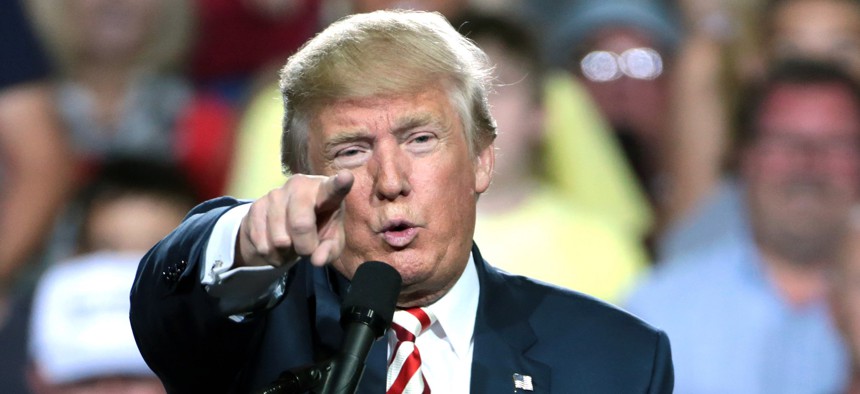
Flickr user Gage Skidmore
How To Measure Trump’s Performance
Pay close attention to the number of House Republicans looking for promotions to the Senate. If they stay put, it’s a sign the president is losing political clout.
For Senate Republicans, these are heady times. Against expectations, they maintained control of their majority and are virtually guaranteed of keeping control of the upper chamber after the 2018 midterms, thanks to a favorable map. With at least 11 Democratic senators in their sights—and only one or two Republicans to defend—they have dreams of a supermajority.
But the optimism of the transition period is soon going to collide with the reality of Trump’s polarizing presidency. The incoming president is alarmingly unpopular even before being sworn in, with just 40 percent of voters viewing him favorably in two new polls. Midterms traditionally run against the party in power, which would make it easier for vulnerable Democrats to argue that they provide a necessary check on his administration. Republicans are facing renewed opposition to repealing President Obama’s health care law, a messy undertaking that is fraught with political risk.
One indicator is worth watching closely for a sign of the GOP’s health in the Trump era: Will ambitious House Republicans, many of whom are in safe seats, look for a promotion to the Senate? Will they bet on voters looking to reward Trump’s first two years with more allies in the Senate, or will they hunker down in the House, fearing a backlash against the president? Any backlash would be fierce, and these members would stand to bear the brunt of it. But in the red states where Trump won big, up-and-coming representatives are apt to run for the Senate whatever the polls say about the president.
“There are three types of [Republican] congressmen: The largest group gets excited to headline a Rotary breakfast in their district; the second group, which is a bit smaller, want to be on Fox News; and the smallest but most important group are the ones who want to be a senator,” said one senior GOP strategist. “They may say they love the House, but the reality is it’s a lot better to be a senator.”
In seven of the 11 states where Democrats are defending Senate seats, GOP representatives would be obvious choices to mount challenges. Rep. Kevin Cramer of North Dakota has already met with Senate Majority Leader Mitch McConnell to discuss a campaign against Sen. Heidi Heitkamp. In Wisconsin, Rep. Sean Duffy is considering a bid; he would provide a populist contrast to liberal Sen. Tammy Baldwin. Democrats are already circulating opposition material against Rep. Pat Meehan, concerned that the suburban Philadelphia congressman could challenge Sen. Bob Casey. Flush with over $2 million in her campaign account, Rep. Ann Wagner of Missouri is as prepared as any Republican to challenge Sen. Claire McCaskill. Her intentions seemed clear when she stepped down from two House leadership positions after last year’s election.
The list of prospective recruits goes on: Rep. Barbara Comstock, fresh off a hard-fought reelection, would be a compelling opponent against Sen. Tim Kaine in Virginia. Rep. Evan Jenkins is one of several Republicans mulling a challenge to Sen. Joe Manchin, who represents West Virginia, the most Trump-friendly state in the country. And several House Republicans from Indiana are eyeing a race against Sen. Joe Donnelly, considered one of the most vulnerable Democrats.
These members’ decisions will tell us a lot about the emerging political landscape. Republicans were able to exceed expectations in 2016 because their coalition of business-friendly conservatives and populist Trump supporters held. In swing Senate races, the GOP candidates ran exceptionally well in the traditionally friendly suburbs while Trump ran up the score in working-class small towns. To the Democrats’ dismay, swing voters didn’t hold congressional Republicans responsible for Trump’s campaign behavior. But that dynamic is bound to change once Trump becomes president.
Next year, Republican challengers have the benefit of a favorable map, but the burden of defending Trump’s record. Tying red-state Democrats to Obama will be tougher now that he’ll have passed from the scene. Repealing Obama’s health care law, as popular as it sounds in red states, could run afoul with enough working-class whites who could end up losing benefits. Meanwhile, Heitkamp and Manchin are strong retail politicians with a long record of winning over voters across the aisle in their small states.
Just look at Montana GOP Rep. Ryan Zinke, viewed as the logical opponent against Sen. Jon Tester in 2018. Despite personal lobbying from McConnell to run for the Senate, he decided to accept Trump’s offer to become secretary of the Interior instead.
For swing-district House Republicans (such as Comstock and Meehan), there will also be cross-pressures from within their party. Their departures would risk ceding their seats to Democrats at a time when the House is more ripe for turnover than the Senate. They’d be running in states that have traditionally backed Democrats, against incumbents who are personally popular. They’d have to be awfully confident that the political mood is still against Democrats, with Trump in charge.
There’s one way for Republicans to hedge their bets on Trump’s political impact. At a time when politicians are viewed so negatively, maybe the tried-and-tested route from the House to the Senate isn’t the smartest strategy. Running as an outsider would be the best way to dodge scrutiny on controversial votes and the taint from Washington.
After all, such a strategy would be consistent with Trump’s own campaign message of draining the swamp.
(Image via Flickr user Gage Skidmore)







